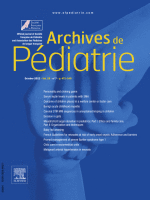Background
In child and adolescent psychiatry, many patients are placed in welfare institutions or foster care.
Objective
It is important to study their progress in the long term and to examine the psychological and social care arrangements as well as their impacts.
Population and methods
This qualitative study designed to identify potential prognostic factors relating to the outcome of children placed in a welfare center or foster care before the age of 4 years was based on the analysis of 34 case histories of children placed in a welfare center or foster care in Angers. These records involved 129 cases collected for the “Saint Ex” study, a quantitative case study conducted from 1994 to 2001 designed to assess the outcome of children placed in a welfare center or foster care in Angers before the age of 4. The population sampling was purposive and was based on eight subgroups defined by three clinical criteria: Parent–Infant Relationship Global Scale assessment (PIR-GAS) at T1 (admission into welfare center or foster care), the status of a “infant at risk” at T1, and GAF (Global Assessment of Functioning) at T2 (exit from the welfare center or foster care).
Results
The study population included 11 girls and 23 boys. Factors contributing to adverse progression included problems with interactions at a very early age, failure to listen or respond to a child's request regarding his or her placement, long delays between establishing facts and implementing social measures, discontinuity and/or inconsistency regarding the placement arrangements, and sexual abuse. On the other hand, factors contributing to positive progress included the diagnosis and adapted treatment of a mental disorder in the case of one or both parents, early placement in a foster family, considering the child's requests regarding the placement, responsiveness of social services, and psychological or psychiatric follow-up.
Conclusion
The analysis of these 34 cases sheds light on several prognostic elements, with the combination of all these factors as the background. Care based on prevention seems essential to protect early interactions and shorten the time that children are exposed to danger.

